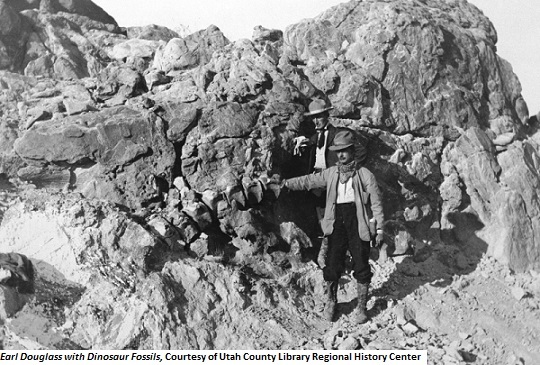Dublin Core
Title
Description
Paleontologist Earl Douglass searched for dinosaur fossils throughout Utah’s remote Uinta Basin during what has been called the “Dinosaur Rush” of the late 1800s.
During the 1870s, Utah was caught up in what some have called the "Dinosaur Rush," which saw the nation’s scientific community feverishly scouring Utah, Colorado, and Wyoming for dinosaur bones to send to museums and private collectors.
A young paleontologist named Earl Douglass was hired by the Carnegie Museum in Pittsburgh to find and identify dinosaur fossils. His search brought Douglass to the Uinta Basin in northeastern Utah in 1907. There, he had huge success in finding several dinosaur species, including an entire brontosaur skeleton, which spanned nearly 70 feet! It took six years for Douglass and his crew to excavate, ship, and reassemble the brontosaur at the Carnegie Museum in Pittsburgh.
Digging for dinosaurs was hard work. Douglass and his crew had to blast the mountainside with dynamite and haul the debris away by hand. When a skeleton was found, more delicate methods were used to prevent destruction of the fragile bones. Excavated fossils were covered with tissue paper and dipped in plaster before being packed in straw and sent to Pittsburgh by horse-drawn freight and railroad. In the first seven years that Douglass spent at the quarry, nine boxcar loads full of dinosaur fossils were sent to Pittsburgh, much to the dismay of Utahns who thought these prehistoric treasures should be kept displayed closer to home.
In 1915 Douglass became concerned about the increasing numbers of homesteaders settling in Uinta Basin, fearing that undiscovered dinosaur bones would be disturbed. President Woodrow Wilson learned of the problem and brought the quarry under federal protection, declaring it as Dinosaur National Monument in October 1915.
The Monument was later enlarged and a local museum built to showcase these amazing dinosaurs. Since the pioneering discoveries of Earl Douglass, many fossils of prehistoric life forms have been discovered throughout Utah, adding to the state's rich scientific heritage.
Creator
Source
Image: Earl Douglass with Dinosaur Fossils. Earl Douglass and an unidentified man stand next to the first dinosaur fossils found in the Uinta Basin. Courtesy of Uintah County Library Regional History Center.
_______________
See Yvette D. Ison, “Dinosaur Rush Created Excitement in Uinta Basin,” History Blazer, March 1995, accessed at http://historytogo.utah.gov; and Mark W. T. Harvey, "Utah, the National Park Service, and Dinosaur National Monument, 1909-56," Utah Historical Quarterly 59 (1991), pp. 243-63.

